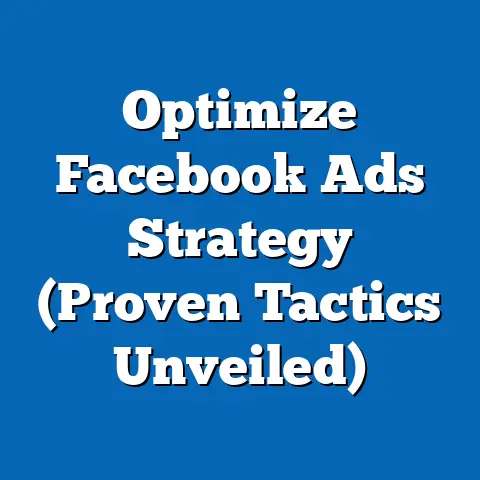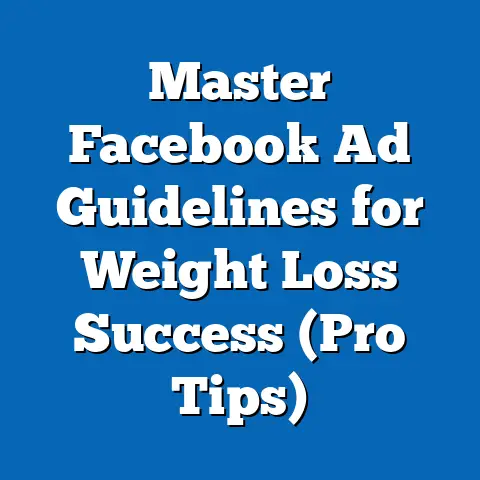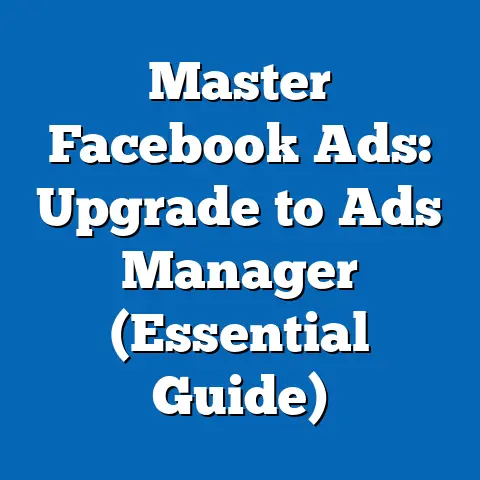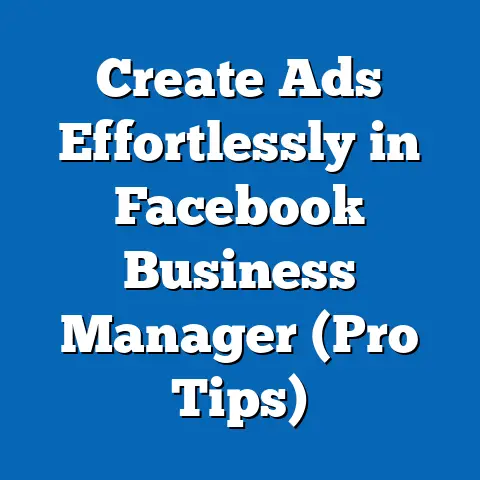How to Restore Deleted Facebook Ad Accounts (Expert Guide)
How to Restore Deleted Facebook Ad Accounts: An Expert Guide
Imagine this: You’ve poured hours, maybe even days, into crafting the perfect Facebook ad campaign. You’ve meticulously researched your audience, A/B tested your creatives, and carefully set your budget. You wake up one morning, ready to check the results, only to find your entire ad account has vanished. Poof! Gone. Panic sets in. Your meticulously crafted ads, the hard-earned data, the potential ROI – all seemingly lost in the digital ether.
Sound like a nightmare? It is. But the good news is, you’re not alone. I’ve seen this happen to countless advertisers, and often, there’s a path to recovery. This guide isn’t just about restoring accounts; it’s about arming you with the knowledge to prevent this from happening in the first place and to navigate the restoration process smoothly if the unthinkable occurs. Let’s get started.
Understanding Facebook Ad Accounts
Before we jump into the recovery process, let’s make sure we’re all on the same page about what a Facebook ad account actually is and why it’s so crucial.
A Facebook ad account is essentially your control panel for running ads on Facebook and Instagram. Think of it as the central hub where you manage your campaigns, set your budgets, define your target audiences, and track your results. It’s tied to your Facebook Business Manager (now Meta Business Suite), which allows you to manage multiple pages, ad accounts, and users in one place.
The Significance in Digital Marketing
Facebook ad accounts are vital for several reasons:
- Targeted Reach: Facebook’s powerful targeting capabilities allow you to reach specific demographics, interests, behaviors, and more. This means you can show your ads to the people most likely to be interested in your products or services.
- Measurable Results: You can track the performance of your ads in real-time, seeing exactly how many people are seeing your ads, clicking on them, and converting into customers.
- Scalability: Facebook allows you to scale your advertising efforts as your business grows. You can start with a small budget and gradually increase it as you see positive results.
Roles and Permissions
Understanding the different roles and permissions within your ad account is crucial for security and management. Here’s a quick rundown:
- Admin: Has full control over the ad account, including the ability to add or remove users, change settings, and create or delete campaigns.
- Advertiser: Can create, edit, and manage campaigns, but cannot change the ad account’s settings or add/remove users.
- Analyst: Can view ad performance data but cannot make any changes to campaigns or settings.
Properly assigning roles ensures that only authorized personnel have access to sensitive information and the ability to make changes to your ad campaigns. I always recommend reviewing permissions regularly, especially when team members leave or their roles change.
Reasons for Deletion
Ad accounts can be deleted for various reasons, some intentional, some accidental:
- User Error: Let’s face it, accidents happen. Someone with admin access might accidentally click the “close ad account” button.
- Policy Violations: Facebook has strict advertising policies, and violating them can lead to account suspension or deletion. This can include anything from promoting prohibited products to using misleading ad copy.
- Account Inactivity: Facebook may close inactive ad accounts after a certain period.
- Billing Issues: Unpaid ad bills or issues with your payment method can lead to account suspension or deletion.
Common Misconceptions
One of the biggest misconceptions is that deleting an ad account is permanent and irreversible. While it’s true that permanently closing an ad account does delete all its data, there’s often a grace period during which you can request restoration. Another misconception is that Facebook will always notify you before deleting your account. While they often do, it’s not guaranteed, especially if the deletion is due to a serious policy violation.
Key Takeaway: Understanding the fundamentals of your Facebook ad account, its roles, and why it might be deleted is the first step in protecting it and knowing how to recover it.
Immediate Steps to Take After Deletion
Okay, so you’ve discovered your ad account is gone. Before you descend into full-blown panic mode, let’s take a deep breath and focus on the immediate steps you need to take.
Don’t Panic, Gather Information
This might sound obvious, but it’s crucial. Panicking will only cloud your judgment. The first thing you need to do is gather as much information as possible. This will be essential when you contact Facebook support.
Here’s what you need to collect:
- Ad Account ID: This is a unique identifier for your ad account. You can usually find it in the URL of your Ads Manager or in previous invoices.
- Business Manager ID (if applicable): If your ad account is linked to a Business Manager, note down its ID as well.
- Ads Examples: Have examples of the ads you were running, including the ad copy, images, and targeting information.
- Billing Information: Have your payment method details ready, including the last four digits of your credit card, billing address, and any recent transaction IDs.
- Reason for Deletion (if known): Did you receive any notifications from Facebook about policy violations or billing issues? Note down the details.
Navigating the Facebook Business Help Center
The Facebook Business Help Center is your lifeline in this situation. It’s where you’ll find the resources and support you need to request account restoration.
Here’s how to navigate it effectively:
- Go to the Facebook Business Help Center: You can find it by searching “Facebook Business Help Center” on Google or by clicking the “Help” icon in your Business Manager.
- Search for Relevant Articles: Use keywords like “deleted ad account,” “restore ad account,” or “reactivate ad account” to find relevant articles.
- Contact Support: If you can’t find the information you need, look for the option to “Contact Support” or “Get Help.” This will usually lead you to a form or chat where you can explain your situation.
Checklist of Information
To make the process smoother, here’s a handy checklist of information to have ready when contacting support:
- [ ] Ad Account ID
- [ ] Business Manager ID (if applicable)
- [ ] Examples of ads you were running
- [ ] Billing information
- [ ] Reason for deletion (if known)
- [ ] Your Facebook profile link
- [ ] A clear and concise explanation of what happened
Key Takeaway: Staying calm, gathering all the necessary information, and knowing how to navigate the Facebook Business Help Center are crucial first steps in the restoration process.
The Restoration Process
Now, let’s get down to the nitty-gritty of actually requesting your ad account’s restoration. This is where patience and clear communication are your best friends.
Step-by-Step Guide
Here’s a step-by-step guide on how to submit a request for account restoration:
- Access the Help Center: As mentioned earlier, start by navigating to the Facebook Business Help Center.
- Locate the Right Support Option: This can sometimes be tricky, as Facebook’s support options can change. Look for options like “Ad Account Issues,” “Account Reactivation,” or “Policy Violations.” If you can’t find a specific option for deleted accounts, choose the one that seems most relevant.
- Fill Out the Necessary Forms: You’ll likely need to fill out a form with details about your ad account and the reason for its deletion. Be as detailed as possible, providing all the information you gathered earlier.
- Explain the Account’s Significance: Emphasize the importance of your ad account to your business. Explain how it’s used for marketing, the impact its deletion has on your business operations, and the potential loss of revenue.
- Acknowledge Any Mistakes (if applicable): If the deletion was due to a policy violation, acknowledge the mistake and explain what steps you’ve taken to ensure it doesn’t happen again.
- Submit Your Request: Once you’ve filled out the form, submit it and wait for a response from Facebook support.
Potential Timelines and Follow-Up
The timeline for restoration requests can vary widely. Some accounts might be restored within a few days, while others might take weeks or even months. It really depends on the complexity of the case and the workload of Facebook support.
Here’s what you can do to follow up:
- Check Your Email Regularly: Facebook support will usually communicate with you via email. Make sure to check your inbox (and spam folder) regularly for updates.
- Respond Promptly: If Facebook support asks for additional information, respond promptly and provide all the details they need.
- Be Patient: It can be frustrating to wait, but try to be patient and avoid bombarding Facebook support with multiple requests. This can actually slow down the process.
- Follow Up (if necessary): If you haven’t heard back from Facebook support after a reasonable amount of time (e.g., a week or two), you can send a polite follow-up email to check on the status of your request.
Potential Outcomes
After submitting your request, there are several possible outcomes:
- Restoration: This is the best-case scenario. Your ad account is restored, and you can resume your advertising activities.
- Denial: Unfortunately, Facebook might deny your request. This can happen if they believe the deletion was justified (e.g., due to serious policy violations) or if they are unable to verify your identity.
- Additional Steps: Facebook might ask you to take additional steps, such as providing more information, verifying your identity, or completing a policy training course.
Key Takeaway: The restoration process requires patience, clear communication, and a willingness to follow Facebook’s instructions. Be prepared for potential delays and different outcomes.
Tips for Successful Restoration
While there’s no guarantee of success, there are several things you can do to improve your chances of getting your ad account back.
Patience and Professionalism
I can’t stress this enough: be patient and professional in your communications with Facebook support. Getting angry or demanding will not help your case. Instead, be polite, respectful, and focus on providing clear and concise information.
Documented Evidence
Documented evidence is your best friend. The more evidence you can provide to support your claim, the better. This can include:
- Screenshots: Take screenshots of your Ads Manager, billing information, and any previous communications with Facebook support.
- Previous Correspondence: If you’ve had previous issues with your ad account, gather any relevant emails or chat logs.
- Business Documents: Have your business license, tax ID, and other relevant documents ready to verify your identity and the legitimacy of your business.
Be Prepared to Explain
Be prepared to explain why your ad account was deleted and what you’ve done to prevent it from happening again. If it was due to a policy violation, acknowledge the mistake, explain how you’ve educated yourself on Facebook’s advertising policies, and outline the steps you’ve taken to ensure compliance in the future.
Key Takeaway: Patience, professionalism, and documented evidence are key to a successful restoration.
Preventing Future Deletions
The best way to deal with a deleted ad account is to prevent it from happening in the first place. Here are some strategies and best practices to safeguard your account:
Regular Backups
While Facebook doesn’t offer a built-in backup feature for ad accounts, you can manually back up your campaigns and settings. This can be time-consuming, but it can save you a lot of headaches in the long run.
Here’s what you can back up:
- Campaign Settings: Document your campaign objectives, targeting options, bidding strategies, and budgets.
- Ad Creatives: Save copies of your ad images, videos, and ad copy.
- Audience Data: Export your custom audiences and lookalike audiences.
Account Permissions Management
Regularly review and update your ad account permissions. Remove any users who no longer need access and ensure that everyone has the appropriate level of access. I’ve seen too many instances where former employees or contractors still had access to ad accounts, posing a security risk.
Access Protocols
Create a solid access protocol for team members. This should include guidelines on how to access the ad account, what actions they are authorized to take, and how to report any issues or concerns.
Two-Factor Authentication
Enable two-factor authentication for all users with access to your ad account. This adds an extra layer of security and makes it much harder for unauthorized users to gain access.
Monitor Account Activity
Regularly monitor your ad account activity for any suspicious or unusual behavior. This can include unexpected changes to campaigns, unauthorized users logging in, or unusual spending patterns. Facebook has tools to help you track this, so make use of them.
Key Takeaway: Proactive measures like regular backups, careful permissions management, and strong security protocols can significantly reduce the risk of accidental or malicious account deletion.
Conclusion
Losing access to your Facebook ad account can be a terrifying experience, especially when your business relies on it for marketing and sales. But remember, it’s not always a dead end. By understanding the restoration process, gathering the necessary information, and communicating effectively with Facebook support, you can often recover your account and get back on track.
More importantly, take the time to implement preventative measures to safeguard your ad account against future deletions. Regular backups, careful permissions management, and strong security protocols are essential for protecting your valuable advertising data and ensuring the continuity of your business.
While the digital landscape can be unpredictable, being informed, proactive, and resilient will help you navigate the challenges and emerge stronger on the other side. So, take a deep breath, follow these steps, and remember that you’re not alone. The road to recovery might be bumpy, but it’s often within reach.






